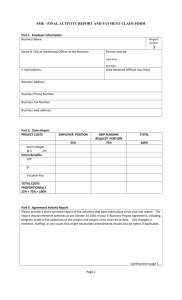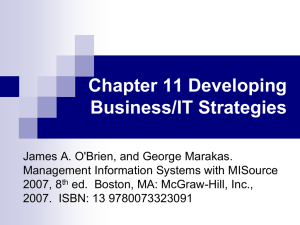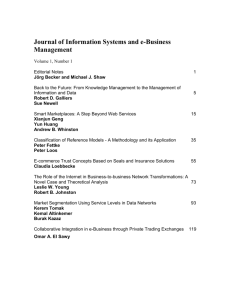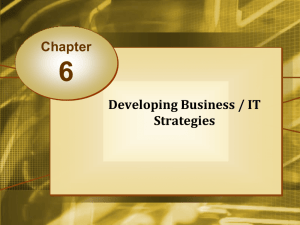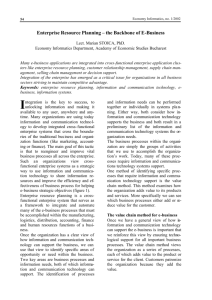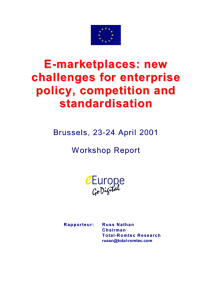E-Marketplaces E
advertisement
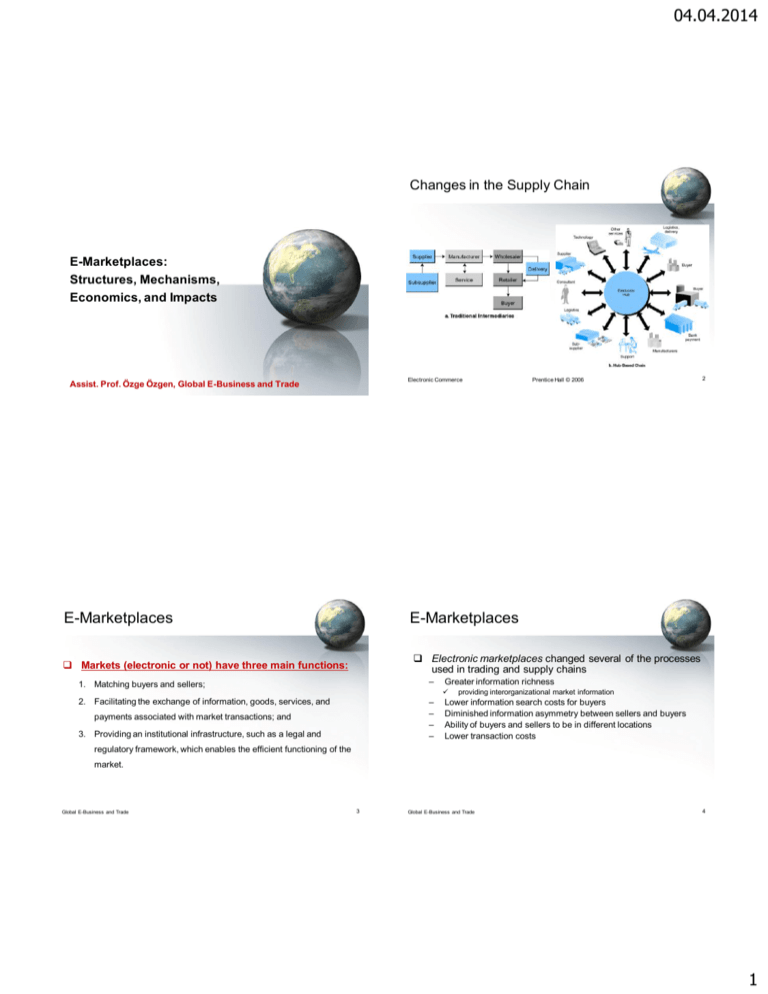
04.04.2014 Changes in the Supply Chain E-Marketplaces: Structures, Mechanisms, Economics, and Impacts Electronic Commerce Assist. Prof. Özge Özgen, Global E-Business and Trade E-Marketplaces Prentice Hall © 2006 2 E-Marketplaces Electronic marketplaces changed several of the processes used in trading and supply chains Markets (electronic or not) have three main functions: 1. Matching buyers and sellers; – 2. Facilitating the exchange of information, goods, services, and – – – – Greater information richness payments associated with market transactions; and 3. Providing an institutional infrastructure, such as a legal and providing interorganizational market information Lower information search costs for buyers Diminished information asymmetry between sellers and buyers Ability of buyers and sellers to be in different locations Lower transaction costs regulatory framework, which enables the efficient functioning of the market. Global E-Business and Trade 3 Global E-Business and Trade 4 1 04.04.2014 E-Marketplaces E-Marketplaces Components – Customers – Sellers – Products and services digital products A marketplace in which sellers and buyers exchange goods and services for money (or for other goods and services), but do so electronically Many-to-many, web-based trading and clolaboration solution that enables companies to buy, sell and collaborate more efficiently in global scale goods that can be transformed into digital format and delivered over the Internet – Infrastructure – Support services Interorganizational information systems which allow the participating buyers and sellers (suppliers) to exchange information about prices and product offerings Electronic Commerce Prentice Hall © 2006 5 Components • Electronic Storefronts storefront A single company’s Web site where products or services are sold • Most common trading mechanisms are a(n): – Electronic catalogue – Auction – Reverse Auction – Exchange front end The portion of an e-seller’s business processes through which customers interact, including the seller’s portal, electronic catalogs, a shopping cart, a search engine, and a payment gateway back end The activities that support online order-taking. It includes fulfillment, inventory management, purchasing from suppliers, payment processing, packaging, and delivery Electronic Commerce 6 Types of E-Marketplaces: From Storefronts to Portals E-Marketplaces • Global E-Business and Trade 7 Global E-Business and Trade 8 2 04.04.2014 Trading Mechanisms Benefits of Electronic Catalogues Catalogue The presentation of product information in an electronic form; the backbone of most e-selling sites Product catalogues of many suppliers in one place in one format Buyers can easily compare it Catalogues can present extensive product information, including Ease of updating Ability to be integrated with the purchasing process Coverage of a wide spectrum of products Interactivity Customization Strong search capabilities multimedia content Product prices posted in a catalogue are normally fixed list prices Global E-Business and Trade 9 www.tradeindia.com Global E-Business and Trade 10 Trading Mechanisms Auction Multiple buyers and sellers bid competitively on a contract OR one seller, many potential buyers Seller driven auction (Forward Auction) Prices are set dynamically through buyers’ bids submitted for products The prices are moving up as a result of bidding among buyers Dynamic Pricing: Prices that change based on supply and demand relationships at any given time Global E-Business and Trade 11 Global E-Business and Trade 12 3 04.04.2014 Trading Mechanisms Dynamic Pricing Dynamic pricing is the strategy of offering different prices to different customers. Firms use dynamic pricing strategy to optimize inventory management and to segment customers. Airlines have long used dynamic pricing to price air travel. There are 2 types of dynamic pricing: Segmented pricing Negotiation. Reverse Auction Buyer driven auction Multiple suppliers bid competitively to provide product to individual buyer Prices tend to fall over time A reverse auction may be organized such that the lowest bid does not automatically win Global E-Business and Trade Global E-Business and Trade 14 Eg: Name-Your-Own-Price The Reverse Auction Process The "Name-Your-Own-Price" system is where a buyer specifies a price and a product and/or service, and asks sellers to match that combination. Originally pioneered by Priceline.com Suppliers benefit because they can sell to the most price-conscious travelers without publicly disclosing those low rates Global E-Business and Trade 15 Global E-Business and Trade 16 4 04.04.2014 Auctions As Trading Mechanisms Types of E-Marketplaces Limitations of E-Auctions Minimal security Possibility of fraud Limited participation Horizontal and Vertical Horizontal e-marketplaces 37% of eBay auctions received bids within the last minute, 12% within the last 10 seconds Offer a product or service across industries and increase their scale by attracting new users People believe that if they bid early, item can be perceived as so valuable www.tradekey.com The winner’s curse Some people pay higher price for auctioned products than they would pay an online retailer Entertainment benefit of online auctions Electronic Commerce Prentice Hall © 2006 17 www.tradekey.com Global E-Business and Trade Vertical e-marketplaces Industry specific e-marketplaces Global E-Business and Trade 18 www.agrelma.com 19 Global E-Business and Trade 20 5 04.04.2014 Types of E-Marketplaces: Ownership Control Models Types of E-Marketplaces Seller-driven e-marketplaces Private and public Promoted by a consortium of suppliers who place offers within the same industry to many buyers Private e-marketplaces Online markets owned by a single company; may be either sell-side Buyer-driven e-marketplaces or buy-side e-marketplaces (one-to-many) Maintained by a few large buying companies that aim at attracting many suppliers AimShifting power to the buyer’s side Public e-marketplaces B2B marketplaces, usually owned and/or managed by an independent third party, that include many sellers and many buyers Open trading environment (many-to-many) Global E-Business and Trade 21 Global E-Business and Trade Revenue Sources Revenue Sources Transaction Fees Membership and License Fees Advertising Professional Service Fees Value-added Service Fees Transaction Fees Global E-Business and Trade 22 The e-marketplace charges a fee that is based on the value of the transaction conducted on the market 23 Global E-Business and Trade 24 6 04.04.2014 Revenue Sources www.tradeindia.com Membership and License Fees One time joining fee Annual maintenance fee for preserving the membership Global E-Business and Trade 25 Revenue Sources Global E-Business and Trade 26 Revenue Sources Advertising Professional Service Fees Banners Hyperlinks to company’s Web Site Links to company’s presentations Commercial e-mail to targeted members Eg: http://www.tradeindia.com/Shopping/product-and-services/banners.html Consulting service Training service Online catalog service Value-added Service Fees come from third parties ispection services logistics etc. Global E-Business and Trade 27 Global E-Business and Trade 28 7 04.04.2014 Online Catalog Service of www.tradeindia.com www.alibaba.com • Adding a detailed description of the company and products online. • Displaying up to 15 photographs of the products/services to attract online visitors. • Choosing the style you want from 5340 attractive catalog designs. • Adding/editing photographs of products online through a personalized user interface called 'My Trade India'. • Sending online trade inquiries to buyers/importers around the globe. • http://seller.alibaba.com/training/vodCourseDetail. htm?courseId=302700003 29 Global E-Business and Trade Global E-Business and Trade 30 Exhibit 2.6 Porter’s Competitive Forces Model Electronic Commerce Prentice Hall © 2006 31 8



